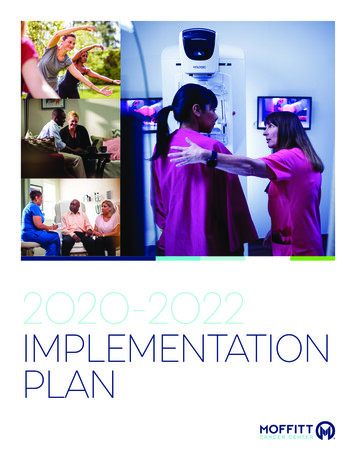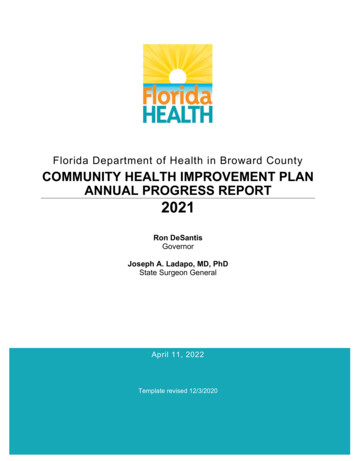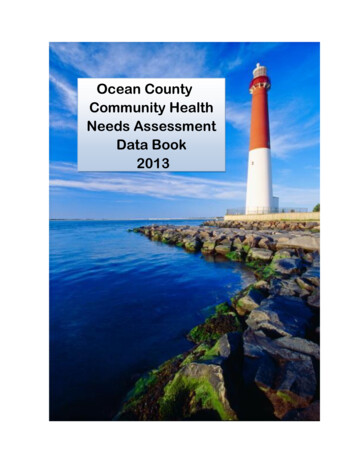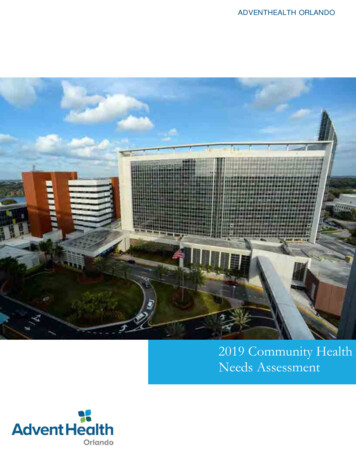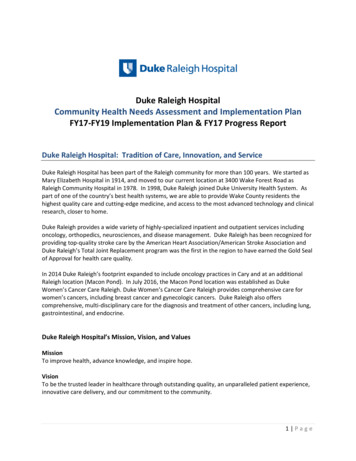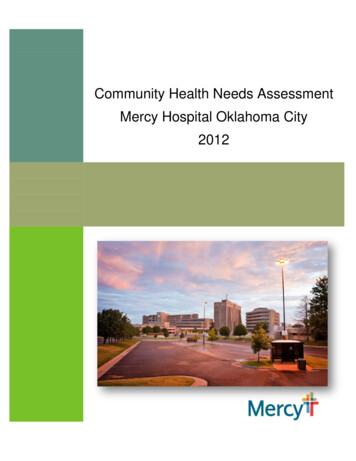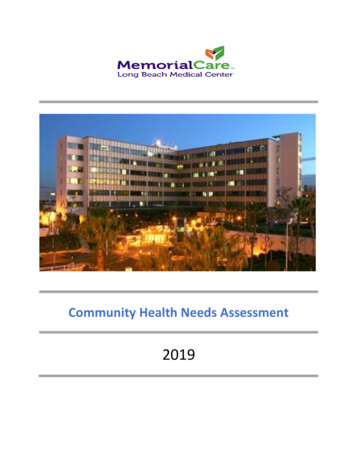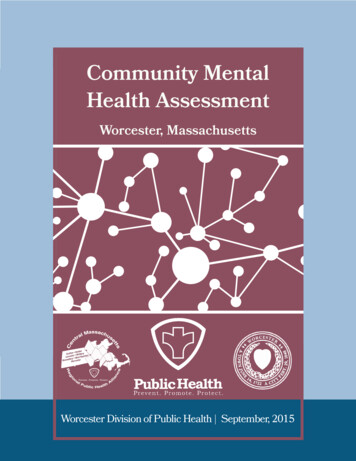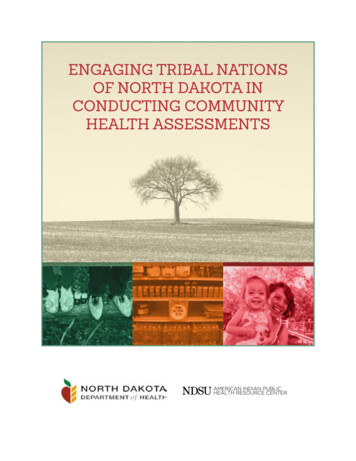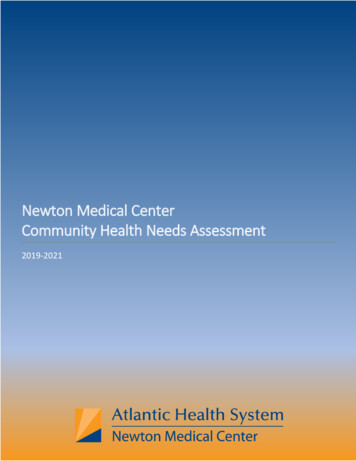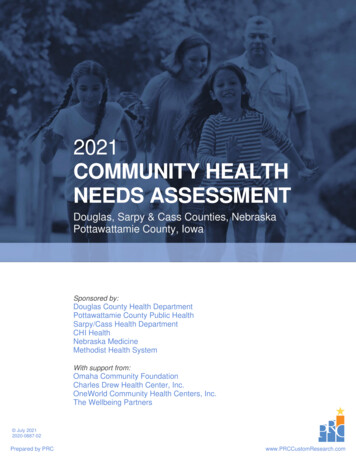
Transcription
2021COMMUNITY HEALTHNEEDS ASSESSMENTDouglas, Sarpy & Cass Counties, NebraskaPottawattamie County, IowaSponsored by:Douglas County Health DepartmentPottawattamie County Public HealthSarpy/Cass Health DepartmentCHI HealthNebraska MedicineMethodist Health SystemWith support from:Omaha Community FoundationCharles Drew Health Center, Inc.OneWorld Community Health Centers, Inc.The Wellbeing Partners July 20212020-0887-02Prepared by PRCwww.PRCCustomResearch.com
TABLE OF CONTENTSINTRODUCTIONPROJECT OVERVIEWProject GoalsApproachMethodologySUMMARY OF FINDINGSSignificant Health Needs of the CommunitySummary Tables: Comparisons With Benchmark Data56677151518COMMUNITY DESCRIPTION33POPULATION CHARACTERISTICS34Total PopulationUrban/Rural PopulationAgeRace & EthnicityLinguistic IsolationSOCIAL DETERMINANTS OF HEALTHPovertyEducationFinancial ResilienceHousingTransportationFood AccessHealth LiteracyEquityHEALTH STATUS343637384041414344465050535459OVERALL HEALTH STATUS60MENTAL HEALTH62Mental Health StatusDepression & AnxietySocial SupportSuicideMental Health TreatmentKey Informant Input: Mental HealthDEATH, DISEASE & CHRONIC CONDITIONSLEADING CAUSES OF DEATHDistribution of Deaths by CauseAge-Adjusted Death Rates for Selected CausesCARDIOVASCULAR DISEASEAge-Adjusted Heart Disease & Stroke DeathsPrevalence of Heart Disease & StrokeKey Informant Input: Heart Disease & StrokeCOMMUNITY HEALTH NEEDS ASSESSMENT62636768697276777777797982832
CANCERAge-Adjusted Cancer DeathsCancer IncidencePrevalence of CancerCancer ScreeningsKey Informant Input: CancerRESPIRATORY DISEASEAge-Adjusted Respiratory Disease DeathsPrevalence of Respiratory DiseaseKey Informant Input: Respiratory DiseaseKey Informant Input: Coronavirus Disease/COVID-19INJURY & VIOLENCEUnintentional InjuryIntentional Injury (Violence)Key Informant Input: Injury & ViolenceDIABETESAge-Adjusted Diabetes DeathsPrevalence of DiabetesKey Informant Input: DiabetesKIDNEY DISEASEAge-Adjusted Kidney Disease DeathsKey Informant Input: Kidney DiseasePOTENTIALLY DISABLING CONDITIONSActivity LimitationsChronic PainAlzheimer’s ENATAL CARE135BIRTH OUTCOMES & RISKS136Low-Weight BirthsInfant Mortality136137FAMILY PLANNING139Births to Adolescent MothersKey Informant Input: Infant Health & Family PlanningMODIFIABLE HEALTH RISKSNUTRITIONDaily Recommendation of Fruits/VegetablesDifficulty Accessing Fresh ProduceSugar-Sweetened BeveragesPHYSICAL ACTIVITYLeisure-Time Physical ActivityActivity LevelsBuilt EnvironmentWEIGHT STATUSAdult Weight StatusKey Informant Input: Nutrition, Physical Activity & WeightCOMMUNITY HEALTH NEEDS 553
SUBSTANCE ABUSEAge-Adjusted Cirrhosis/Liver Disease DeathsAlcohol UseAge-Adjusted Unintentional Drug-Related DeathsUse of Prescription OpioidsAlcohol & Drug TreatmentKey Informant Input: Substance AbuseTOBACCO USECigarette SmokingUse of Vaping ProductsKey Informant Input: Tobacco UseSEXUAL lly Transmitted Infections (STIs)Key Informant Input: Sexual Health175177178ACCESS TO HEALTH CARE180HEALTH INSURANCE COVERAGE181Type of Health Care CoverageLack of Health Insurance Coverage181181DIFFICULTIES ACCESSING HEALTH CAREDifficulties Accessing ServicesBarriers to Health Care AccessKey Informant Input: Access to Health Care ServicesPRIMARY CARE SERVICESAccess to Primary CareSpecific Source of Ongoing CareUtilization of Primary Care RGENCY ROOM UTILIZATION193ORAL HEALTH194Dental CareKey Informant Input: Oral HealthLOCAL RESOURCES194195197PERCEPTIONS OF LOCAL HEALTH CARE SERVICES198HEALTH CARE RESOURCES & FACILITIES200Federally Qualified Health Centers (FQHCs)Resources Available to Address the Significant Health NeedsCOMMUNITY HEALTH NEEDS ASSESSMENT2002014
INTRODUCTION
PROJECT OVERVIEWProject GoalsThis Community Health Needs Assessment, a follow-up to similar studies conducted in 2011, 2015, and2018, is a systematic, data-driven approach to determining the health status, behaviors, and needs ofresidents in the Omaha metropolitan area (including Douglas, Sarpy, Cass, and Pottawattamie counties).Subsequently, this information may be used to inform decisions and guide efforts to improve communityhealth and wellness.A Community Health Needs Assessment provides information so that communities may identify issues ofgreatest concern and decide to commit resources to those areas, thereby making the greatest possibleimpact on community health status. This Community Health Needs Assessment will serve as a tool towardreaching three basic goals: To improve residents’ health status, increase their life spans, and elevate their overall quality of life.A healthy community is not only one where its residents suffer little from physical and mentalillness, but also one where its residents enjoy a high quality of life. To reduce the health disparities among residents. By gathering demographic information along withhealth status and behavior data, it will be possible to identify population segments that are most atrisk for various diseases and injuries. Intervention plans aimed at targeting these individuals maythen be developed to combat some of the socio-economic factors that historically have had anegative impact on residents’ health. To increase accessibility to preventive services for all community residents. More accessiblepreventive services will prove beneficial in accomplishing the first goal (improving health status,increasing life spans, and elevating the quality of life), as well as lowering the costs associated withcaring for late-stage diseases resulting from a lack of preventive care.This assessment was led by a coalition comprised of local public health departments, health systems,federally qualified health centers, and community-based organizations.SPONSORING ORGANIZATONS Douglas County Health Department; Pottawattamie CountyPublic Health; Sarpy/Cass Health Department; CHI Health (CHI Health Creighton University MedicalCenter–Bergan Mercy, CHI Health Immanuel, CHI Health Lakeside, CHI Health Mercy Council Bluffs,and CHI Health Midlands); Nebraska Medicine (Bellevue Medical Center and Nebraska MedicalCenter); and Methodist Health System (Methodist Hospital, Methodist Jennie Edmundson Hospital,and Methodist Women’s Hospital).SUPPORTING ORGANIZATONS Omaha Community Foundation; Charles Drew Health Center,Inc.; One World Community Health Centers, Inc.; and The Wellbeing PartnersThis assessment was conducted by Professional Research Consultants, Inc. (PRC). PRC is a nationallyrecognized health care consulting firm with extensive experience conducting Community Health NeedsAssessments in hundreds of communities across the United States since 1994.COMMUNITY HEALTH NEEDS ASSESSMENT6
ApproachThe process for this assessment follows anapproach as outlined in the Community HealthAssessment Toolkit developed by the Associationfor Community Health ImprovementTM (ACHI). Inthe ACHI model (at right), collaboratingorganizations worked through the first three stepsin this process, and this assessment documentand subsequent communication activities will carrythe community engagement model through Step 6.Steps 7 through 9 will be undertaken by thepartnering hospitals, health departments, and otherorganizations over the next three years, at whichtime the process begins again and thisassessment will be updated.MethodologyThis assessment incorporates data from multiple sources, including primary research (through the PRCCommunity Health Survey and PRC Online Key Informant Survey), as well as secondary research (vitalstatistics and other existing health-related data). It also allows for trending and comparison to benchmarkdata at the state and national levels.PRC Community Health SurveySurvey InstrumentThe survey instrument used for this study is based largely on the Centers for Disease Control andPrevention (CDC) Behavioral Risk Factor Surveillance System (BRFSS), as well as various other publichealth surveys and customized questions addressing gaps in indicator data relative to health promotion anddisease prevention objectives and other recognized health issues. The final survey instrument wasdeveloped by the sponsoring and supporting organizations and PRC and is similar to the previous surveysused in the region, allowing for data trending.Community Defined for This AssessmentThe study area for the survey effort (referred to as the “Metro Area” in this report) includes Douglas, Sarpy,and Cass counties in Nebraska, as well as Pottawattamie County in Iowa. For this study, Douglas County isfurther divided into five geographical areas (Northeast Omaha, Southeast Omaha, Northwest Omaha,Southwest Omaha, and Western Douglas County). This community definition is illustrated in the followingmap.COMMUNITY HEALTH NEEDS ASSESSMENT7
Sample Approach & DesignA precise and carefully executed methodology is critical in asserting the validity of the results gathered in thePRC Community Health Survey. Thus, to ensure the best representation of the population surveyed amixed-mode methodology was implemented. This included surveys conducted via telephone (landline andcell phone), as well as through online questionnaires.The sample design used for this effort consisted of a stratified random sample of 2,854 individuals age 18and older in the Metro Area, including 1,451 in Douglas County, 702 in Sarpy County, 200 in Cass County,and 501 in Pottawattamie County. The higher Douglas County sample reflects a target of 50 surveys per ZIPCode within the county (although some lesser-populated ZIP Codes did not reach this threshold). Once theinterviews were completed, these were weighted in proportion to the actual population distribution so as toappropriately represent the Metro Area as a whole. All administration of the surveys, data collection, anddata analysis was conducted by PRC.For statistical purposes, the maximum rate of error associated with a sample size of 2,854 respondents is 1.8% at the 95 percent confidence level.COMMUNITY HEALTH NEEDS ASSESSMENT8
Expected Error Ranges for a Sample of 2,855Respondents at the 95 Percent Level of Confidence 2.0 1.8 1.6 1.4 1.2 1.0 0.8 0.6 0.4 0.2 The "response rate" (the percentage of a population giving a particular response) determines the error rate associated with that response. A "95 percent level ofconfidence" indicates that responses would fall within the expected error range on 95 out of 100 trials.If 10% of the sample of 2,855 respondents answered a certain question with a "yes," it can be asserted that between 8.9% and 11.1% (10% 1.1%) of the totalpopulation would offer this response.If 50% of respondents said "yes," one could be certain with a 95 percent level of confidence that between 48.2% and 51.8% (50% 1.8%) of the total populationwould respond "yes" if asked this question.Sample CharacteristicsTo accurately represent the population studied, PRC strives to minimize bias through application of a proventelephone methodology and random-selection techniques. While this random sampling of the populationproduces a highly representative sample, it is a common and preferred practice to “weight” the raw data toimprove this representativeness even further. This is accomplished by adjusting the results of a randomsample to match the geographic distribution and demographic characteristics of the population surveyed(poststratification), so as to eliminate any naturally occurring bias. Specifically, once the raw data aregathered, respondents are examined by key demographic characteristics (namely sex, age, race, ethnicity,and poverty status), and a statistical application package applies weighting variables that produce a samplewhich more closely matches the population for these characteristics. Thus, while the integrity of eachindividual’s responses is maintained, one respondent’s responses may contribute to the whole the sameweight as, for example, 1.1 respondents. Another respondent, whose demographic characteristics may havebeen slightly oversampled, may contribute the same weight as 0.9 respondents.The following chart outlines the characteristics of the Metro Area sample for key demographic variables,compared to actual population characteristics revealed in census data. [Note that the sample consistedsolely of area residents age 18 and older.]COMMUNITY HEALTH NEEDS ASSESSMENT9
Population & Survey Sample CharacteristicsSources:Notes:Women18 to 3940 to 6465 .1%12.4%16.0%15.6%Men79.9%Other races include:Black7.2%Asian2.4%American Native 1.3%Multiple/Other1.2%42.1%42.0%41.9%Final Survey Sample42.4%50.9%51.1%49.1%48.9%Actual Population79.7%(Metro Area, 2021)Hispanic 200% FPLUS Census Bureau, 2011-2015 American Community Survey.2021 PRC Community Health Survey, PRC, Inc.FPL is federal poverty level, based on guidelines established by the US Department of Health & Human Services.The sample design and the quality control procedures used in the data collection ensure that the sample isrepresentative. Thus, the findings may be generalized to the total population of community members in thedefined area with a high degree of confidence.INCOME & RACE/ETHNICITYINCOME Poverty descriptions and segmentation used in this report are based on administrativepoverty thresholds determined by the US Department of Health & Human Services. These guidelinesdefine poverty status by household income level and number of persons in the household (e.g., the2020 guidelines place the poverty threshold for a family of four at 26,200 annual household incomeor lower). In sample segmentation: “very low income” refers to community members living in ahousehold with defined poverty status; “low income” refers to households with incomes just above thepoverty level and earning up to twice (100%-199% of) the poverty threshold; and “mid/high income”refers to those households living on incomes which are twice or more ( 200% of) the federal povertylevel.RACE & ETHNICITY In analyzing survey results, mutually exclusive race and ethnicity categoriesare used. All Hispanic respondents are grouped, regardless of identity with any other race group.Other race categories are non-Hispanic categorizations (e.g., “White” reflects non-Hispanic Whiterespondents).Online Key Informant SurveyTo solicit input from key informants, those individuals who have a broad interest in the health of thecommunity, an Online Key Informant Survey also was implemented as part of this process. A list ofrecommended participants was provided by the sponsoring organizations; this list included names andcontact information for physicians, public health representatives, other health professionals, social serviceproviders, and a variety of other community leaders. Potential participants were chosen because of theirability to identify primary concerns of the populations with whom they work, as well as of the communityoverall.COMMUNITY HEALTH NEEDS ASSESSMENT10
Key informants were contacted by email, introducing the purpose of the survey and providing a link to takethe survey online; reminder emails were sent as needed to increase participation. In all, 150 communitystakeholders took part in the Online Key Informant Survey, as outlined below:ONLINE KEY INFORMANT SURVEY PARTICIPATIONKEY INFORMANT TYPENUMBER PARTICIPATINGPhysician28Advanced Practice Provider2Social Services Provider32Public Health Representative6Other Health Providers54Business Leader8Criminal Justice2Other Community Leaders18Final participation included representatives of the organizations outlined below. American Red Cross Heartland Chapter Heartland Workforce Solutions City of Bellevue Iowa West Foundation Bennington Public Schools Kountze Memorial Lutheran Church Charles Drew Health Center, Inc. Metropolitan Area Planning Agency (MAPA) CHI Health Methodist Health System Child Saving Institute Methodist College City of Omaha Metro Area Continuum Care For Health CityMatCH Mid-Iowa Family Therapy Clinic & ITPS Claire Memorial United Methodist Church National Safety Council of Nebraska College of St. Mary Nebraska Medicine Completely Kids Nebraska Urban Indian Health Coalition Court Appointed Special Advocate (CASA) Nonprofit Association of the Midlands Creighton Multicultural Community Affairs NOVA Treatment Community, Inc. Creighton University Omaha City Council Douglas County Health Department Omaha Community Foundation Eastern Nebraska Office of Aging (ENOA) Omaha Housing Authority Family Housing Advisory Service–North Omaha Metro (MAT) Girls Incorporated Of Omaha One World Community Health Center Gretchen Swanson Center for Nutrition Omaha Public Schools Health Care Administrator City of PapillionCOMMUNITY HEALTH NEEDS ASSESSMENT11
Pottawattamie County Public Health Together, Inc. Of Metropolitan Omaha Project Harmony Tri-City Food Pantry Ralston Public Schools Salem Baptist ChurchUniversity of Nebraska Medical Center(UNMC) Sarpy County Health Department UNMC College of Public Health Southeast Nebraska Community Action UNMC College of Dentistry SealantProgram City of Springfield University of Nebraska Omaha (UNO) TEAM (Tobacco Education and Advocacy ofthe Midlands) Visiting Nurse Association The Wellbeing Partners YMCAThrough this process, input was gathered from several individuals whose organizations work with lowincome, minority, or other medically underserved populations.In the online survey, key informants were asked to rate the degree to which various health issues are aproblem in their own community. Follow-up questions asked them to describe why they identify problemareas as such and how these might better be addressed. Results of their ratings, as well as their verbatimcomments, are included throughout this report as they relate to the various other data presented.NOTE: These findings represent qualitative rather than quantitative data. The Online Key Informant Surveywas designed to gather input regarding participants’ opinions and perceptions of the health needs of theresidents in the area.Public Health, Vital Statistics & Other DataA variety of existing (secondary) data sources was consulted to complement the research quality of thisCommunity Health Needs Assessment. Data for the Metro Area were obtained from the following sources(specific citations are included with the graphs throughout this report): Center for Applied Research and Engagement Systems (CARES), University of MissouriExtension, SparkMap (sparkmap.org) Centers for Disease Control & Prevention, Office of Infectious Disease, National Center forHIV/AIDS, Viral Hepatitis, STD, and TB Prevention Centers for Disease Control & Prevention, Office of Public Health Science Services, Center forSurveillance, Epidemiology and Laboratory Services, Division of Health Informatics andSurveillance (DHIS) Centers for Disease Control & Prevention, Office of Public Health Science Services, NationalCenter for Health Statistics Douglas County Health Department ESRI ArcGIS Map Gallery National Cancer Institute, State Cancer Profiles OpenStreetMap (OSM) US Census Bureau, American Community Survey US Census Bureau, County Business PatternsCOMMUNITY HEALTH NEEDS ASSESSMENT12
US Census Bureau, Decennial Census US Department of Agriculture, Economic Research Service US Department of Health & Human Services US Department of Health & Human Services, Health Resources and Services Administration(HRSA) US Department of Justice, Federal Bureau of Investigation US Department of Labor, Bureau of Labor StatisticsBenchmark DataTrendingSimilar surveys were administered in the Metro Area in 2011, 2015, and 2018 by PRC. Trending data, asrevealed by comparison to prior survey results, are provided throughout this report whenever available.Historical data for secondary data indicators are also included for the purposes of trending.Nebraska & Iowa Risk Factor DataStatewide risk factor data are provided where available as an additional benchmark against which tocompare local survey findings; these data represent the most recent BRFSS (Behavioral Risk FactorSurveillance System) Prevalence and Trends Data published online by the Centers for Disease Control andPrevention. State-level vital statistics are also provided for comparison of secondary data indicators.Nationwide Risk Factor DataNationwide risk factor data, which are also provided in comparison charts, are taken from the 2020 PRCNational Health Survey; the methodological approach for the national study is similar to that employed in thisassessment, and these data may be generalized to the US population with a high degree of confidence.National-level vital statistics are also provided for comparison of secondary data indicators.Healthy People 2030Healthy People provides 10-year, measurable public health objectives — and tools to help trackprogress toward achieving them. Healthy People identifies public health priorities to helpindividuals, organizations, and communities across the United States improve health and wellbeing. Healthy People 2030, the initiative’s fifth iteration, builds on knowledge gained over thefirst four decades.Healthy People 2030’s overarching goals are to: Attain healthy, thriving lives and well-being free of preventable disease, disability, injury, andpremature death. Eliminate health disparities, achieve health equity, and attain health literacy to improve the healthand well-being of all. Create social, physical, and economic environments that promote attaining the full potential forhealth and well-being for all. Promote healthy development, healthy behaviors, and well-being across all life stages. Engage leadership, key constituents, and the public across multiple sectors to take action anddesign policies that improve the health and well-being of all.COMMUNITY HEALTH NEEDS ASSESSMENT13
The Healthy People 2030 framework was based on recommendations made by the Secretary’s AdvisoryCommittee on National Health Promotion and Disease Prevention Objectives for 2030. After gettingfeedback from individuals and organizations and input from subject matter experts, the U.S. Department ofHealth and Human Services (HHS) approved the framework which helped guide the selection of HealthyPeople 2030 objectives.Determining SignificanceDifferences noted in this report represent those determined to be significant. For survey-derived indicators(which are subject to sampling error), statistical significance is determined based on confidence intervals (atthe 95 percent confidence level), using question-specific samples and response rates. For the purpose ofthis report, “significance” of secondary data indicators (which do not carry sampling error but might besubject to reporting error) is determined by a 15% variation from the comparative measure.Information GapsWhile this assessment is quite comprehensive, it cannot measure all possible aspects of health in thecommunity, nor can it adequately represent all possible populations of interest. It must be recognized thatthese information gaps might in some ways limit the ability to assess all of the community’s health needs.For example, certain population groups — such as the homeless, institutionalized persons, or those whoonly speak a language other than English or Spanish — are not represented in the survey data. Otherpopulation groups — for example, pregnant women, lesbian/gay/bisexual/transgender residents,undocumented residents, and members of certain racial/ethnic or immigrant groups — might not beidentifiable or might not be represented in numbers sufficient for independent analyses.In terms of content, this assessment was designed to provide a comprehensive and broad picture of thehealth of the overall community. However, there are certainly medical conditions that are not specificallyaddressed.Public CommentParticipating hospitals and health systems made their prior Community Health Needs Assessment (CHNA)reports publicly available through their respective websites; through that mechanism, they requested fromthe public written comments and feedback regarding the CHNA and implementation strategies. At the timeof this writing, none had not received any written comments. However, through population surveys and keyinformant feedback for this assessment, input from the broader community was considered and taken intoaccount when identifying and prioritizing the significant health needs of the community. Participatinghospitals will continue to use their websites as tools to solicit public comments and ensure that thesecomments are considered in the development of future CHNAs.COMMUNITY HEALTH NEEDS ASSESSMENT14
SUMMARY OF FINDINGSSignificant Health Needs of the CommunityThe following “Areas of Opportunity” represent the significant health needs of the community, based on theinformation gathered through this Community Health Needs Assessment. From these data, opportunities forhealth improvement exist in the area with regard to the following health issues (see also the summary tablespresented in the following section).The Areas of Opportunity were determined after consideration of various criteria, including: standing incomparison with benchmark data (particularly national data); identified trends; the preponderance ofsignificant findings within topic areas; the magnitude of the issue in terms of the number of persons affected;and the potential health impact of a given issue. These also take into account those issues of greatestconcern to the community stakeholders (key informants) giving input to this process.AREAS OF OPPORTUNITY IDENTIFIED THROUGH THIS ASSESSMENT Insurance Instability Barriers to AccessACCESS TO HEALTHCARE SERVICES Appointment Availability Lack of Transportation Routine Medical Care (Adults) Emergency Room Utilization Health LiteracyCANCER Leading Cause of Death Cervical Cancer Screening [Age 21-65]DIABETES Diabetes Deaths Diabetes Prevalence Blood Sugar Testing [Non-Diabetics]HEART DISEASE& STROKE Leading Cause of Death Stroke PrevalenceINFANT HEALTH &FAMILY PLANNING Prenatal Care Infant DeathsINJURY & VIOLENCE Prevalence of Falls [Age 45 ] Intimate Partner ViolenceMENTAL HEALTH “Fair/Poor” Mental HealthDiagnosed DepressionSymptoms of Chronic DepressionSuicide DeathsSocial SupportReceiving Treatment for Mental HealthDifficulty Obtaining Mental Health ServicesKey Informants: Mental health ranked as a top concern.—continued on the following page—COMMUNITY HEALTH NEEDS ASSESSMENT15
AREAS OF OPPORTUNITY (continued)NUTRITION,PHYSICAL ACTIVITY& WEIGHT Fruit/Vegetable ConsumptionLeisure-Time Physical ActivityAccess to TrailsOverweight & ObesityProfessional Advice on Weight [Overweight Adults]Key Informants: Nutrition, physical activity, and weight ranked as a topconcern.ORAL HEALTH Regular Dental Care [Adults]POTENTIALLYDISABLINGCONDITIONS RESPIRATORYDISEASE Lung Disease Deaths [Chronic Lower Respiratory Disease] Asthma Prevalence [Adults]SEXUALHEALTH Chlamydia Incidence Gonorrhea Incidence HIV Testing [Age 18-44]SOCIALDETERMINANTS OFHEALTH Housing Insecurity Loss of Utilities Unhealthy/Unsafe HousingSUBSTANCE ABUSE Cirrhosis/Liver Disease Deaths Key Informants: Substance abuse ranked as a top concern.TOBACCO USE Smokers Advised to Quit by a Health ProfessionalCOMMUNITY HEALTH NEEDS ASSESSMENTActivity LimitationsHigh-Impact Chronic PainAlzheimer’s Disease DeathsCaregiving16
Community Feedback on Prioritization of Health NeedsPrioritization of the health needs identified in this assessment (“Areas of Opportunity” above) wasdetermined based on a prioritization exercise conducted among community stakeholders (representing across-section of community-based agencies and organizations) in conjunction with the administration of theOnline Key Informant Survey.In this process, these key informants were asked to rate the severity of a variety of health issues in thecommunity. Insofar as these health issues were identified through the data above and/or were identified astop concerns among key informants, their ranking of these issues informed the following priorities:1.Mental Health2.Nutrition, Physical Activity & Weight3.Substance Abuse4.Diabetes5.Sexual Health6.Injury & Violence7.Heart Disease & Stroke8.Tobacco Use9.Infant Health & Family Planning10. Potentially Disabling Conditions11. Oral Health12. Access to Healthcare Services13. Respiratory Diseases14. CancerSocial determinants of health (e.g., housing issues) were not part of this prioritization exercise, but willcertainly be viewed as an overarching issue and considered in all actions that sponsoring organizationschoose to implement.Hospital Implementation StrategiesSponsoring hospitals will use the information from this Community Health Needs Assessment to developImplementation Strategies to address the significant health needs in the community. While the hospitals willlikely not implement strategies for all of the health issues listed above, the results of this prioritizationexercise will be used to inform the development of action plans to guide community health improvementefforts in the coming years.COMMUNITY HEALTH NEEDS ASSESSMENT17
Summary Tables:Comparisons With Benchmark DataReading the Summary Tables In the following tables, Metro Area results are shown in the larger, gray column. The group of columns furthest to the left provide comparisons among the five subareas within DouglasCounty, identifying differences for each as “better than” (B), “worse than” (h), or “similar to” (d) thecombined opposing areas of Douglas County. The second grouping of columns [to the left of the Metro Area column] provide comparisons among thefour counties assessed, identifying differences for each as “better than” (B), “worse than” (h), or “sim
The study area for the survey effort (referred to as the "Metro Area" in this report) includes Douglas, Sarpy, and Cass counties in Nebraska, as well as Pottawattamie County in Iowa. For this study, Douglas County is further divided into five geographical areas (Northeast Omaha, Southeast Omaha, Northwest Omaha,
